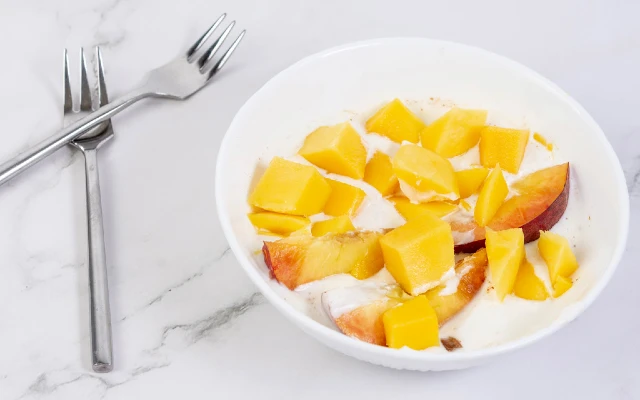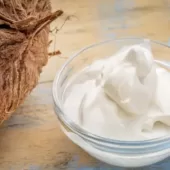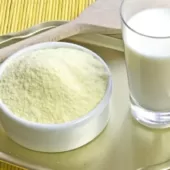Though Greek yogurt has long been my favorite, I’ve never stopped to think about the difference from regular yogurt. Other than preferring the thicker texture. But now I’ve compared this PRAL list for Greek yogurt against the Regular Yogurt PRAL List. That comparison has given me new insights into how some dairy foods affect alkaline diet.
I’ll share those insights now. But you can skip to the Greek Yogurt PRAL List if you just want the numbers.
Why is Greek Yogurt More Acidic Than Regular?
What we refer to as Greek yogurt is essentially regular yogurt that is strained. Which means that whey is drained from yogurt until it reaches the desired thick consistency. Today, I learned from some PRAL-related cheese making studies[1-2]. Because those studies explain how the biggest change in cheese PRAL values occurs during whey draining. So scientists who understand PRAL-based alkaline diet measurement ensure they group dairy foods accurately.
During cheese production, the alkaline whey is separated, therefore PRAL of cheese is higher than that of the original milk[3].
How to Make Alkaline Greek Yogurt
There are two approaches to changing acid-forming Greek yogurt into an alkalizing meal:
- Add alkalizing flavorings – usually fruit. This is a key aspect of all alkaline diet meals. Where we start with a protein consumption target. Then add alkalizing ingredients to provide overall alkalinity for each meal.
- Switch from acid-forming cows milk to alkalizing plant-based milk.
Unfortunately, USDA’s nutrient database doesn’t include any plant-based Greek yogurt. So you might buy it, or make your own. Currently, I’m still searching for a recipe that produces acceptable results. Please let me know on the feedback form below if you have any recommendations for plant-based Greek yogurt. In the meantime, I’ll stay with adding fruit. Though I’m also enjoying Greek yogurt in alkaline meals when I use it as a salad dressing.
Acid-Alkaline Greek Yogurt List
Before you use this PRAL Greek Yogurt List, you must understand and agree to PRAL Food Lists Principles.
I list yogurt with the lowest PRAL index first. Because these have the lowest acid load. So the least acid forming foods show first. But you can click the food table headings to change sort order.
| Main food description | Energy (kcal per 100 g) | PRAL (100 g) |
PRAL ( 100 calories ) |
|---|---|---|---|
| Yogurt, Greek, NS as to type of milk or flavor | 73 | 5.20 | 7.12 |
| Yogurt, Greek, NS as to type of milk, plain | 73 | 5.20 | 7.12 |
| Yogurt, Greek, whole milk, plain | 97 | 4.86 | 5.01 |
| Yogurt, Greek, low fat milk, plain | 73 | 5.20 | 7.12 |
| Yogurt, Greek, nonfat milk, plain | 59 | 5.31 | 9.00 |
| Yogurt, Greek, NS as to type of milk, fruit | 103 | 3.92 | 3.81 |
| Yogurt, Greek, whole milk, fruit | 106 | 3.69 | 3.48 |
| Yogurt, Greek, low fat milk, fruit | 103 | 3.92 | 3.81 |
| Yogurt, Greek, nonfat milk, fruit | 82 | 3.83 | 4.67 |
| Yogurt, Greek, NS as to type of milk, flavors other than fruit | 95 | 4.49 | 4.73 |
| Yogurt, Greek, whole milk, flavors other than fruit | 111 | 4.40 | 3.96 |
| Yogurt, Greek, low fat milk, flavors other than fruit | 95 | 4.49 | 4.73 |
| Yogurt, Greek, nonfat milk, flavors other than fruit | 78 | 4.51 | 5.78 |
| Yogurt, Greek, with oats | 154 | 4.79 | 3.11 |
For the Greek yogurt category, the average PRAL values are 4.56 per 100 grams and 5.25 per 100 calories. To put this in context, compare with other dairy foods in the Food Category List.

Your Alkaline Greek Yogurt
Remember, factors such as growing conditions, variety, and preparation methods affect all food nutrients. USDA database values are an average of many samples. So your PRAL values for yogurt will vary from day to day. But they are always an estimate of actual acid load on your kidneys. Which I explain more in the notes about PRAL principles on the category list page.
Leave Acid-Alkaline Greek Yogurt PRAL List to browse the Complete PRAL Food Category List.
Greek Yogurt Related Topics
Please remember: to find more related pages that are relevant to you, use the search box near the top of every page.
Common Terms: milk
Other posts that include these terms:
- Acid-Alkaline Whole Milk PRAL List
- Acid-Alkaline Low Fat Milk PRAL List
- Acid-Alkaline Oatmeal PRAL List
- Acid-Alkaline Milk Substitutes PRAL List
- Acid-Alkaline Milk Shakes PRAL List
- Acid-Alkaline Reduced Fat Milk PRAL List
- Acid-Alkaline Regular Yogurt PRAL List
Acid-Alkaline Greek Yogurt PRAL List References
- GORE, E., J. MARDON, D. GUERINON, A. GARDANES, and A. LEBECQUE. “Evolution of Potential Renal Acid Load (PRAL) during the cheese-making process of Fourme d’Ambert.” 3
rd International Conference and Exhibition on Nutrition & Food Sciences September 23-25, 2014 Valencia, Spain - Gore, Ecaterina, Julie Mardon, and Annick Lebecque. “Draining and salting as responsible key steps in the generation of the acid-forming potential of cheese: Application to a soft blue-veined cheese.” Journal of dairy science 99, no. 9 (2016): 6927-6936.
- Alexy, Ute, Mathilde Kersting, and Thomas Remer. “Potential renal acid load in the diet of children and adolescents: impact of food groups, age and time trends.” Public health nutrition 11, no. 3 (2008): 300-306.



